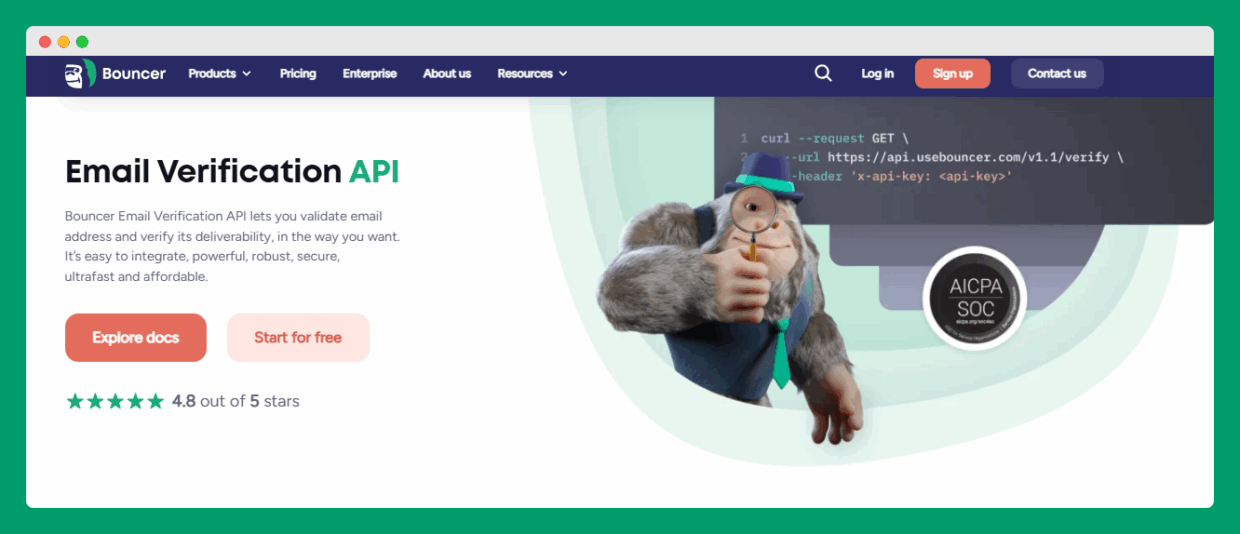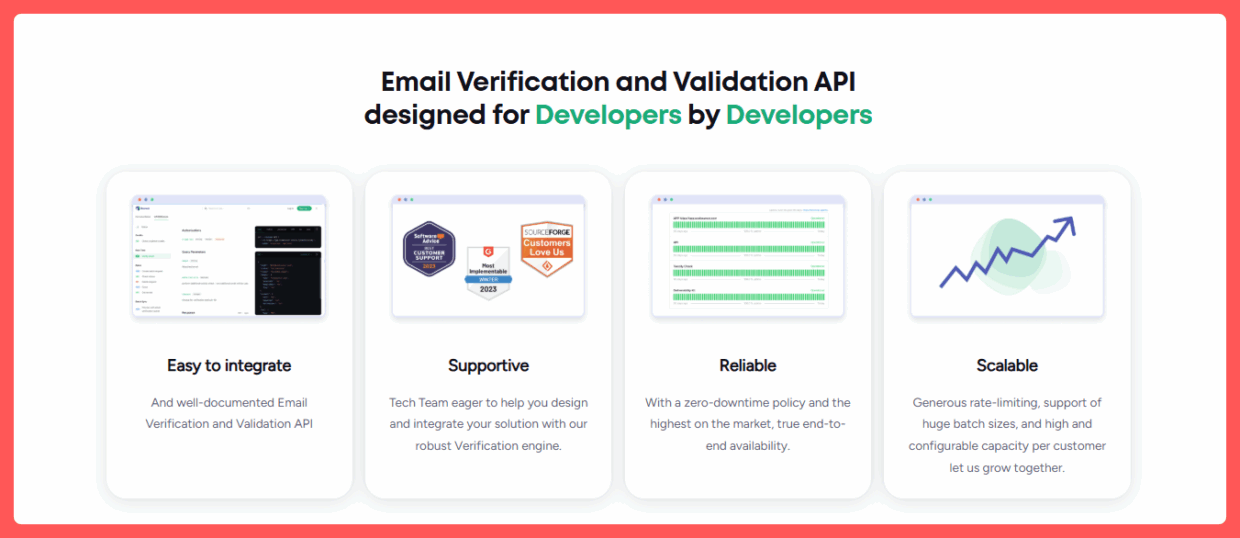But is it still the best fit for your current setup? Some tools now offer similar power with simpler integration, more control, or better pricing.
In this review, we’ll break down what the NeverBounce API can do, where it might fall short, and which alternative could be a better match for your workflow.
TL;DR
- NeverBounce’s API offers solid real-time checks, bulk verification, webhooks, and integrations, but it can be complex for non-technical users and lacks transparent API-specific pricing.
- You can embed verification on websites, connect CRMs and ESPs, automate list cleaning, and run free list analyses—but workflows often require polling, manual setup, or extra coding.
- While capable, NeverBounce’s accuracy concerns and limited pricing clarity mean many teams prefer alternatives with faster, simpler, and more transparent API workflows.
What is the NeverBounce API?

The NeverBounce API is a service that allows developers to integrate email verification capabilities into their applications.
The API supports both individual email verifications and bulk verification requests. It enables customized integrations for various software solutions and provides callbacks for successful or failed verification responses.
NeverBounce API top features

NeverBounce‘s verification API is packed with features that are designed to keep email lists accurate and up-to-date.
Here’s a rundown of its core capabilities.
- Real time. It verifies email addresses as users enter them and prevents bad data from entering your lists.
- Bulk email verification. You can upload and verify large batches of emails in one go.
- Webhook support. You can get instant updates and receive notifications about the status of each verification.
- Email address validation. The API checks each email’s format and whether the domain exists. Emails on your list will be well-formed and reach valid domains.
- Detecting temporary and disposable emails. You can quickly weed out temporary or disposable email addresses that can clutter your list and lead to unreliable metrics.
- Detailed status codes. The API provides comprehensive status codes (such as valid, invalid, and disposable) and allows for better list management.
- API key. For added security, you can manage access through multiple unique API keys. This feature helps authenticate requests securely.
- Analytics and reporting. You can get valuable insights into your email list’s health with built-in analytics and reporting.

What can you do with the API?
The API from NeverBounce offers quite a lot. You can connect NeverBounce account with other tools, build custom workflows, and even embed it into your website.
Let’s get to more details.

Integrating tools and platforms
The NeverBounce API can connect seamlessly with CRMs like Salesforce, marketing platforms like HubSpot, and email marketing tools like Mailchimp. Integrating with such platforms allows you to validate emails before they’re automatically added to your lists.
NeverBounce also lets you create custom integrations, so you can adapt your account to your system’s unique tools or workflows.
- Example: You’re using Mailchimp to handle email marketing. You can set up a process where every email added to Mailchimp goes through NeverBounce verification. As a result, you will prevent invalid emails from reaching your lists.
Note: To securely use NeverBounce’s API, you’ll need an API username (a unique identifier for your application) and a secret key for authentication (it acts as a password that adds a layer of security.) These credentials let only authorized users interact with the API.
Embedding verification on your website
NeverBounce API offers a JavaScript Widget for easy direct embedding on your site.
This widget verifies email addresses in real-time, which is particularly useful for sign-up or contact forms.
The widget’s API (available as window._nb.api in the browser) has a few handy methods, such as getValidatePublic, which verifies an email entered by the user.
- Example code:
_nb.api.getValidatePublic('user@example.com',
function(result) {
console.log(result); // Returns a result object with verification data
},
function(err) {
console.log(err); // Returns error message if verification fails
}
);
Note: If you are not a developer, handling the APIs may seem complicated. Using this widget is a better choice for non-technical users.
Building custom workflows with API endpoints

With NeverBounce’s API, you can use various triggers, actions, and searches to create custom workflows. For example, to automate bulk email verification, real-time checking, or specific list verification processes.
Also, the bulk endpoint can run sample checks on lists to estimate bounce rates without incurring costs.
- Example: If you have an extensive list of contacts, you can use the jobs/create endpoint to upload and verify a CSV list. NeverBounce’s API handles this process, from indexing to deduplication, with the ability to check verification status through polling.
- Example code:
curl --request POST \
--url https://api.neverbounce.com/v4/jobs/create \
--data key=your_api_key \
--data input_location='remote_url' \
--data filename='YourFile.csv' \
--data input='https://yourdomain.com/YourFile.csv'
Once submitted, this job runs until completion, and you can poll the jobs/status endpoint to check its progress.
Using webhooks for real-time updates
NeverBounce’s webhook support allows for automated result processing. Once verification is completed, you will receive notifications on the status of each verification.
It’s a good way to automate data pipelines, where each change in verification status triggers specific actions in your CRM or email system.
- Example: If an email is verified invalid, the webhook can trigger a workflow to mark the contact inactive in your CRM. Your lists will be constantly updated with verified contacts.
Running free analysis to assess list health
If you’re unsure whether a complete verification is necessary, NeverBounce’s API offers a free analysis feature to assess your list’s overall health.
This option provides an estimated bounce rate and helps you decide if further action is required. To get an estimate, create a job with the run_sample parameter.
- Example code:
curl --request POST \
--url https://api.neverbounce.com/v4/jobs/create \
--data key=your_api_key \
--data input_location='remote_url' \
--data filename='YourFile.csv' \
--data input='https://yourdomain.com/YourFile.csv' \
--data run_sample=1Optimizing email and list verification

Moreover, NeverBounce’s API offers help for optimization, whether it’s verifying individual emails or validating bulk lists.
You can check single emails as they are entered (e.g., at the point of form submission) or entire lists to clean up existing databases.
When you upload a list through the API, NeverBounce automatically indexes and deduplicates the entries, which helps remove duplicates and spot invalid or risky emails before sending.
You can also use the following request to verify a single email.
- Example code:
curl --request POST\
--url https://api.neverbounce.com/v4/single/check?key={api_key}&email={email}
This command allows you to verify a single email using the NeverBounce API by substituting your api_key and the email you want to check.
Note: The standard API from NeverBounce is not suitable for use in client-side scripts (e.g., React, Angular, Vue, jQuery, and other Javascript frameworks), as it would involve revealing sensitive API credentials. Using a Javascript widget is, therefore, a more suitable option.

How much does it cost?
NeverBounce does not provide information on the cost of its API service, but it does provide a general price list on its website.
The platform offers two tiers: Basic Plans and Sync. In Basic Plans, you can choose from three options: Starter, Advanced, and Pro. The lowest price is $8 per 1,000 credits.
The pay-as-you-rates are here as well.
In the Sync model, you have pricing tiers: from up to 1,000 emails to over 1,000,000. The lowest price is $10.00 when paid monthly.

What else should you know about NeverBounce pricing?
First, they offer free credits to get you started, which is helpful if you’re just testing things out.
As your email verification needs grow, volume discounts are available, which can lower costs for high-volume users.
A nice feature is the free deduplication service, which automatically cleans out duplicates and syntax errors at no extra cost.
NeverBounce offers free list analysis for list health checks. This service is useful if you want to understand list quality upfront.
Does NeverBounce pricing have any drawbacks?
NeverBounce’s pricing structure has attractive features, but consider the other side of the coin:
- The significant discounts only apply at higher usage tiers (up to 2 million credits), which may be out of reach for smaller businesses or those with less frequent verification needs.
- For businesses with ongoing needs, the pay-as-you-go model might become expensive over time, mainly if you verify emails regularly but don’t quite reach the volume needed for discounted rates.
- While each plan includes all features, this could feel unnecessary for those who only need basic verification and don’t require advanced options like list analysis or deduplication.
- Unlike some competitors, NeverBounce doesn’t seem to offer lower prices for long-term commitments.
While NeverBounce offers a straightforward approach, it may feel somewhat limiting for small-to-medium businesses needing fewer credits or more customizable plans.
Also, check out:
👉 NeverBounce Login Info Lost Again? Here’s How to Deal With It
👉 Neverbounce vs Zerobounce – The Ultimate Showdown
👉 NeverBounce vs BriteVerify: Pricing, Plans, and Features
The better alternative to the Neverbounce API
You may try another solution to maintain high email deliverability rates, improve customer engagement, and enhance marketing efforts by ensuring their email lists are clean and up-to-date.
Here’s the Bouncer email verification API.

Bouncer’s API is designed for large companies and SMEs. Its clear documentation, straightforward setup, and real-time and batch verification support make it incredibly versatile for developers.
The API is fast and precise for real-time verification. It reduces errors from typos on registration forms and helps maintain a clean email list. If bulk verification is needed, Bouncer handles up to 500,000 emails simultaneously, with an impressive processing speed of 180,000 emails per hour.

This platform’s API will come in handy in various use cases.
For example, when you want to quickly (but accurately) verify the entire database before a big Black Friday campaign.
But Bouncer’s API also goes beyond basic verification.
It offers deep insights with rich data output and provides information like:
- deliverability status,
- toxicity flags,
- email provider information,
- and more.
You can see if an address is disposable, role-based, or from a free provider.
This information is extremely valuable for B2B companies that want to avoid personal email domains.
Moreover, Bouncer’s technology is adept at handling tricky addresses, like catch-all emails and those protected by advanced anti-spam filters.
Of course, the best way to learn more about the Bouncer API is to contact us and tell us about your needs. We can have a low-key conversation so you can find a solution without pressure.
But we’ll mention briefly that the Bouncer platform and API are safe tools.
Bouncer’s GDPR-compliant API ensures that sensitive data is kept safe in AWS European data centers. API keys are kept secure by using HTTPS and can be included only in request headers, not URLs, which minimizes the risk of exposure.
And for additional protection, you can use multi-factor authentication.

Choose the best verification API for your needs
As you can see, Bouncer’s API is a powerful alternative to NeverBounce.
Unmatched flexibility, reliability, and security for email verification. That’s precisely what you’ll get if you choose Bouncer.
Our platform provides a powerful, scalable solution for your growing business needs. If you want to find out for yourself, nothing is stopping you.

